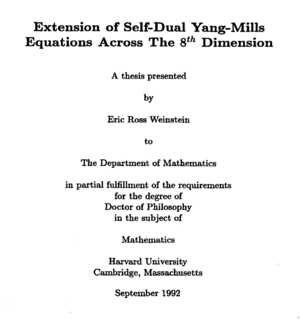Extension of Self Dual Yang-Mills equations across the 8th dimension (Content)
Eric Weinstein's dissertation, "Extension of Self-Dual Yang-Mills Equations Across the Eighth Dimension," extends self-dual Yang-Mills equations from four-dimensional spaces to eight-dimensional manifolds, aiming to broaden the applicability of these foundational equations in mathematical physics. The dissertation formulates a system of elliptic partial differential equations defined over eight-dimensional Riemannian manifolds, involving spinor structures and connections on principal bundles associated with Spin(8) symmetry. It explores the existence of solutions in special cases, such as on the eight-dimensional sphere and Einstein manifolds, while also sketching generalizations to other even dimensions. The work intricately ties together concepts from representation theory, gauge theory, and geometric structures, setting up a framework for higher-dimensional extensions of Yang-Mills theory.
A particularly significant aspect is found in Section 6.8, titled "Spin(10) Phenomenology." Here, Weinstein bridges the mathematical framework with physical theories, particularly the Standard Model of particle physics. By considering a Riemannian immersion into a ten-dimensional space, the dissertation shows how the quantum numbers of fundamental particles can emerge from the reduction of the Spin(10) structure group, aligning with the Standard Model's particle representations. This section emphasizes how higher-dimensional geometry, specifically using Spin(10) symmetry, provides insights into the quantum characteristics of particles, thereby offering a geometric and mathematical foundation for exploring phenomenology in physics. This connection between sophisticated geometric equations and physical theories underscores the potential of the dissertation's approach to unify mathematical structures with particle physics in higher dimensions, hinting at what Weinstein would continue to develop into the Theory of Geometric Unity.
Summary by Chapter[edit]
Introduction[edit]
This dissertation presents a mathematical exploration of extending self-dual Yang-Mills equations, which are typically confined to four-dimensional spaces, to higher dimensions—specifically focusing on eight-dimensional manifolds. In the mid-1970s, mathematicians began exploring self-dual Yang-Mills equations, originally formulated for four-dimensional spaces, where the star operator had unique properties. This dissertation aims to extend these concepts to eight-dimensional spaces, showing that the theories applicable to four dimensions can be generalized to eight and potentially higher even dimensions.
Basic Material and Notation[edit]
This chapter covers fundamental concepts from representation theory, geometry, and gauge theory. It introduces the mathematical objects and notations used throughout the dissertation, such as irreducible representations, Spin and SO groups, and various tensor operations. The properties of Spin(8), a key symmetry group in eight dimensions, are explored, along with the decomposition of tensor products relevant to the eight-dimensional setting.
Further Constructs[edit]
In this chapter, Weinstein discusses specific representations and geometric constructions that are crucial for formulating the extended self-dual Yang-Mills equations in higher dimensions. The chapter includes discussions on constructing certain principal bundles over the eight-dimensional manifold and the detailed algebraic properties of various spin representations.
Equations[edit]
The core equations defining the generalized self-dual Yang-Mills framework are presented. These equations are formulated as a system of nonlinear partial differential equations over eight-dimensional manifolds, involving connections on specific principal bundles. The ellipticity of these equations and their mathematical implications, including index theory for the associated differential operators, are discussed in depth.
Solutions[edit]
This chapter provides solutions to the formulated equations under specific conditions, such as on the eight-dimensional sphere. It demonstrates how conformal transformations can generate a moduli space of solutions and discusses the properties of these solutions in relation to conformal structures. The existence of solutions on Einstein manifolds is also established.
Further Remarks[edit]
The final chapter extends the discussion to potential generalizations in other dimensions and different types of geometric structures, such as G-structures in dimensions six and seven. It also explores the peculiarities of low-dimensional cases and possible modifications to the bundle and operator choices in different dimensions.
More specifically, Section 6.8, titled "Spin(10) Phenomenology," discusses the physical motivations behind the mathematical framework developed in the dissertation. It connects the theory to the Standard Model of particle physics, which describes fundamental particles as sections of specific vector bundles over space-time. In the Standard Model, the group \(G = SU(3) \times SU(2) \times U(1)\) is used, and fermions appear as 16-dimensional complex representations, with three families representing distinct particle generations.
Weinstein extends this approach by considering the geometry of a Riemannian immersion into higher dimensions, specifically focusing on the case where the ambient dimension \(j\) is 10. He shows that by reducing the structure group of the normal bundle via a chain of inclusions leading to Spin(10), one can recover the quantum numbers of the Standard Model's particles through the splitting of the Dirac operator when restricted to the lower-dimensional sub-manifold. This connection suggests that Spin(10) particle phenomenology provides a geometric motivation for studying sophisticated equations governing Spin-bundles in higher dimensions, thus supporting the search for first-order Yang-Mills equations that extend aspects of the four-dimensional theory.
Appendices[edit]
The appendices include technical details, such as Mathematica code used to perform specific calculations, and elaborate on the determinant computations for the elliptic operators defined earlier.

